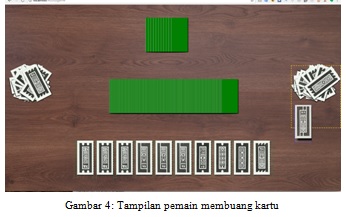Analisa Penggunaan WebRTC dan Websocket pada Real Time Multiplayer Online Game Tradisional Ceki
Abstract
Ceki is one of the traditional card games that has been quite popular in Malaysia, Singapore and Indonesia. In Bali the game of ceki has become a tradition, where the game is played when there is community activity. Multiplayer online games are one way to introduce and develop traditional games to be more interesting to play. The problems that are often faced to develop multiplayer online games include the latency problems that are different from each player so that it can interfere with games from other players who have better latency. In this study, a real time multiplayer online game will be built to play traditional games. discussing how the rules of traditional games obtained from the rules of the Balinese game will be applied to the game engine from online multiplayer games, how to implement online game multiplayer architecture on client-server and peer to peer web-browsers. The focus of this research is on the performance of the use of websocket and webRTC on latency and bandwidth usage for data synchronization that supports real time multiplayer online games based on peer to peer. The results obtained from this study see the average latency needed to synchronize data between websocket compared to webRTC is very significant. The number of players has no effect on latency in both websocket and webRTC.
Downloads
References
[2] D.Varun Ranganathan, Design Patterns for Multiplayer Card Games. Computer, Communication and Signal Processing (ICCCSP). Chennai: IEEE, 2017.
[3] H. C. Kusuma, Rancang Bangun Aplikasi Massive Multiplayer Online Role Playing Game Berbasis Client-Server dengan Optimaliasi Paket. Electronic computers. Computer science, Surabaya, jul. 2011.
[4] M. Somantri, A. Darmariyadi, Penerapan Pengolahan Paralel Model Cluster Sebagai Web Server. Majalah Ilmiah Teknologi Elektro, [S.l.], v. 6, n. 1, jan. 2007. ISSN 2503-2372. Available : https://ojs.unud.ac.id/index.php/JTE/article/view/233.
[5] P. L Greco, (2017). HTML5 WebSocket: A Quantum Leap in Scalability for the Web. Retrieved from websocket.org: http://www.websocket.org/quantum.html.
[6] Mozilla Developer Network. (2015). Websockets. Retrieved from MDN web docs: https://developer.mozilla.org/en-US/docs/Glossary/WebSockets.
[7] Yuzo Fujishima, F. U. (2009, Desember 9). Web Sockets Now Available In Google Chrome. Retrieved from blog.chromium.org: https://blog.chromium.org/2009/12/web-sockets-now-available-in-google.html.
[8] I. Fette, A. Melnikov, Relationship to TCP and HTTP, RFC 6455 The WebSocket Protocol. IETF. sec. 1.7, Dec. 2011.
[9] K. K. Dev, WebRTC Implementation Analysis and Impact of Bundle Feature, International Conference on Communication Systems and Network Technologies. 5. Gwalior, India: IEEE, 2015.
[10] L. A. Sajjad Taheri, WebRTCBench: A Benchmark for Performance Assessment of WebRTC Implementations, Embedded Systems For Real-time Multimedia (ESTIMedia). 13, Amsterdam: IEEE, 2015.
[11] W3C, WebRTC 1.0: Real-time Communication Between Browsers. Available: https://www.w3.org/TR/2008/WD-html5-20080610/comms.html#tcp-connections, 2018.


This work is licensed under a Creative Commons Attribution-NonCommercial-NoDerivatives 4.0 International License.

This work is licensed under a Creative Commons Attribution 4.0 International License




